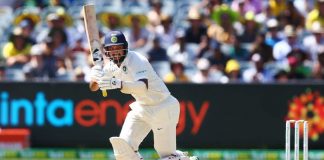DECEMBER 31, 2020
Brief Scorecard: New Zealand 431 (Williamson 129, Watling 73, Taylor 70, Nicholls 56, Afridi 4-109, Yasir 3-113) and 180 for 5 dec (Blundell 64, Latham 53, Naseem 3-55) beat Pakistan 239 (Ashraf 91, Rizwan 71, Jamieson 3-35) and 271 (Alam 102, Rizwan 60, Southee 2-33, Jamieson 2-35, Santner 2-52, Wagner 2-55, Boult 2-72) by 101 runs

The New Zealand players converge on Mitchell Santner after he took the final wicket. – Getty Images
In April 1988, Pakistan survived 129 overs in the fourth innings to save a famous Test match in Trinidad with just one wicket left, against a West Indies pace quartet of its time.
Thirty-two years and eight months later, Pakistan came within four-and-a-half overs of pulling off a near-repeat, against a New Zealand pace quartet that is now surely of comparable quality to that West Indies attack, certainly in its own conditions.
Let’s leave comparisons be, for now. Let’s focus instead on the enthralling, excruciating, and/or devastating final day, depending on how you view it, that unfolded at Mount Maunganui. It was the kind of day that Test-cricket addicts hold up as examples to convert the skeptical.
It was a day full of heroes. Eleven-and-a-half years after his first Test hundred, Fawad Alam scored a second, and spent 380 balls in the company of Mohammad Rizwan, to bring Pakistan to within sight of a draw, against all odds. It was the eighth-longest fourth-innings partnership of all time, in all Test matches for which balls-faced data is available.
Alam and Rizwan, who came together in the second over of the day’s play, were still together with just 25.2 overs remaining. They had seen off 22.4 overs of the second new ball, on a pitch that had almost nothing to offer the fast bowlers when the ball was old.
New Zealand needed six wickets in those 25.2 overs, and they found a way through, and how.
Neil Wagner was the pulsing heart of New Zealand’s victory. He bowled 49 overs across the two innings, and took four wickets, two in each innings. He ran in with intensity, ball after ball, testing right- and left-hander from every possible angle of attack, frequently digging it in short, as is his wont, but by no means exclusively so, and did it all with two broken toes.
“Unless they carry me off on a stretcher, I’m going to try and do everything I can,” Wagner had said at the end of the third day, when New Zealand had been clear favourites to win.

Neil Wagner, broken toe and all, produced the key breakthrough to dismiss centurion Fawad Alam. – Getty Images
By the end of his 11-over spell in the final session of the Test match, he may well have had just enough energy left in the tank to clamber onto that stretcher. By then, however, he had blown open a Test match that, at tea, might have seemed to be slipping away from a lesser attack.
For the first 40 minutes or so of the final session, nothing seemed to happen off the deck. The bowlers seemed tired, the short ball was sitting up, and Alam and Rizwan picked up four fours in the first six overs after tea.
But the threat of inconsistent bounce still hung over the batsmen, and they stayed vigilant, playing anything remotely within the line of the stumps with the straightest of bats. Then, in the 11th over after tea, Kyle Jamieson finally forced half an error from Rizwan, who got a touch too far across his stumps to a ball angled into the stumps from wide of the crease. Having to play slightly across the line in defence, he couldn’t get his bat down in time as it shot through low and struck his front pad.
New Zealand successfully reviewed the not-out decision, and energy coursed through their ranks once more.
From the other end, Wagner kept coming, kept asking awkward questions of the batsman. Nineteen balls after Rizwan’s dismissal, he coaxed (bulldozed might be a better verb) an error out of Alam. He attacked the left-hander with short balls from left-arm around, climbing at unpredictable heights from his blind spot outside his leg stump. He stuck two forward short legs in his peripheral vision.
Alam had judged the short ball exceedingly well and played the pull with authority through his innings. But now he got cramped by a shoulder-high ball down the leg side, and gloved it to wicketkeeper BJ Watling. His resistance had lasted 396 minutes and 269 balls.
Pakistan had just one recognised batsman left, and it was Wagner, again, who prised him out. He kept attacking Faheem Ashraf with the short ball, and Ashraf kept pulling him, controlling nearly all of them except one that flew over the head of deep backward square leg stationed a few yards inside the rope. Then Wagner sent down a good-length ball in the corridor, and got it to straighten by the tiniest degree. Ashraf could have covered the movement with a half-decent front-foot stride, but he failed to get one in, having been pushed back by all those short balls.
At that point, New Zealand needed just three wickets with 16.1 overs remaining. But Pakistan’s lower order wouldn’t give up. Between them, Mohammad Abbas, Naseem Shah and Shaheen Afridi – who underwent multiple concussion checks after ducking into a Wagner bouncer early in his innings – resisted the bowling for 80 balls. The pitch was flat enough by now for Nos. 9, 10 and 11 to get in line and defend Trent Boult and Tim Southee with a reasonable degree of comfort.

Fawad Alam added 165 with Mohammad Rizwan in 63.2 overs. – Getty Images
It fell to Mitchell Santner to take the last two wickets. The left-arm spinner hadn’t exactly justified his selection until tea, failing to offer the control required of a frontline Test-match spinner and getting pulled and cut repeatedly by Alam in particular, who scored 32 off 34 balls against him.
But the ball was turning sharply on occasion when pitched in the right spot, and Kane Williamson went back to Santner against the tailenders, crowding them with as many as six close catchers. And over the course of his last four overs, broken into two spells, he finally made an impact, trapping Abbas lbw with a well-directed slider, and then, with time nearly running out, having Naseem caught-and-bowled with a ball that seemed to stick in the turf.
It was a fitting finish, because the day had been defined by the slowness of the pitch and its sapping effect on ball and bat.
Alam and Rizwan came together in the second over of the morning, when Azhar Ali, batting on 38 off 119 at that point, nicked off attempting an uncharacteristically loose push outside off stump to a fullish ball from Boult that seamed away to accentuate it’s angle across the right-hand batsman.
Both Alam and Rizwan took time coming to terms with the slow surface initially, surviving moments of early indecision when they reached out well in front of the body to drive. But once they got used to the pitch, they turned its lack of pace into an ally that gave them time to negotiate its vagaries of bounce.
The fast bowlers threw everything they could at them, using unusual angles and setting unorthodox fields to try and prise out a breakthrough. At one point, Boult bowled to Alam with two slips, two gullies, two short covers, short leg and short midwicket in place. Jamieson, the tallest of the New Zealand quicks, got the odd ball to climb unexpectedly in the corridor, and skid through at knee height on other occasions, both from just short of a length. Wagner’s bouncers frequently climbed barely a couple of feet over the stumps, causing the batsmen to duck awkwardly to evade them.
But they got through the uncomfortable periods, and gradually began to shift the day’s momentum, with batting getting easier as the ball aged. By the time the new ball arrived, Rizwan had faced more than 100 balls and Alam nearly 200, and they began finding the boundary with greater frequency, even as the uncertain bounce increased in frequency and magnitude. As the final session approached its final hour, belief surged through both camps. On another day, Alam and Rizwan may well have outlasted Wagner and Jamieson.
Courtesy/Source: ESPNCricinfo































































































